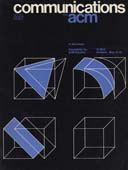April 1975 - Vol. 18 No. 4

Features
Computer networks in higher education: socio-economic-political factors
This study presents the results of a nationwide survey of computer networks in higher education conducted during 1971-73. Five major and 18 minor networks were identified. The five major networks included: the ARPA Net, the California State College network, the University of Iowa/Iowa State University network, the Michigan Educational Research Information Triad, Inc., and the Triangle Universities Computation Center network in North Carolina. In-depth studies were conducted of the latter two nets. Based on the experiences of these operating networks, a number of factors are identified for consideration in developing networks. Finally, recommendations are advanced regarding the development of networks in higher education in the future.
The Dilogarithm function of a real argument [S22]
The dilogarithm function [1-3], defined by Li2(x) = - ∫x0 (1/z) ln (1 - z) dz, (1) occurs in several different applications in physics and engineering, ranging from quantum electrodynamics, to network analysis, to the thermodynamics of ideal ferromagnets, to the structure of polymers. A new function subroutine is developed which computes the dilogarithm function of a real argument to an accuracy of a few parts in 1015. This program was designed to be included in the usual package of library subprograms relied upon by most users. It employs an alternative computational approach to a previously published algorithm [4].
On maintenance of the opportunity list for class-teacher timetable problems
One of the principal components of procedures for the solution of class-teacher timetable problems is that for maintenance of the opportunity list. Opportunity list maintenance methods are based on necessary conditions for the existence of a solution. A general framework for necessary conditions, together with four specific sets of necessary conditions, is given.
The synthesis of solids bounded by many faces
A technique is presented which allows a class of solid objects to be synthesized and stored using a computer. Synthesis begins with primitive solids like a cube, wedge, or cylinder. Any solid can be moved, scaled, or rotated. Solids may also be added together or subtracted. Two algorithms to perform addition are described. For practical designers, the technique has the advantage that operations are concise, readily composed, and are given in terms of easily imagined solids. Quite short sequences of operations suffice to build up complex solids bounded by many faces.
The quadratic hash method when the table size is not a prime number
Previous work on quadratic hash methods is limited mainly to the case where the table size is a prime number. Here, certain results are derived for composite numbers. It is shown that all composite numbers containing at least the square of one of the component primes have full-period integer-coefficient quadratic hash functions.
A modification of Warshall’s algorithm for the transitive closure of binary relations
An algorithm is given for computing the transitive closure of a binary relation that is represented by a Boolean matrix. The algorithm is similar to Warshall's although it executes faster for sparse matrices on most computers, particularly in a paging environment.
An algorithm for locating adjacent storage blocks in the buddy system
A simple scheme for the determination of the location of a block of storage relative to other blocks is described. This scheme is applicable to the buddy type storage allocation systems.
A comparison of simulation event list algorithms
Four algorithms are considered which can be used to schedule events in a general purpose discrete simulation system. Two of the algorithms are new, one is based on an end-order tree structure for event notices, and another uses an indexed linear list. The algorithms are tested with a set of typical stochastic scheduling distributions especially chosen to show the advantages and limitations of the algorithms. The end-order tree algorithm is shown to be an advantageous, immediate replacement for the algorithm in use with current simulation languages. The most promising algorithm uses the indexed list concept. It will require an adaptive routine before it can be employed in general purpose simulators, but its performance is such that further study would be fruitful.



